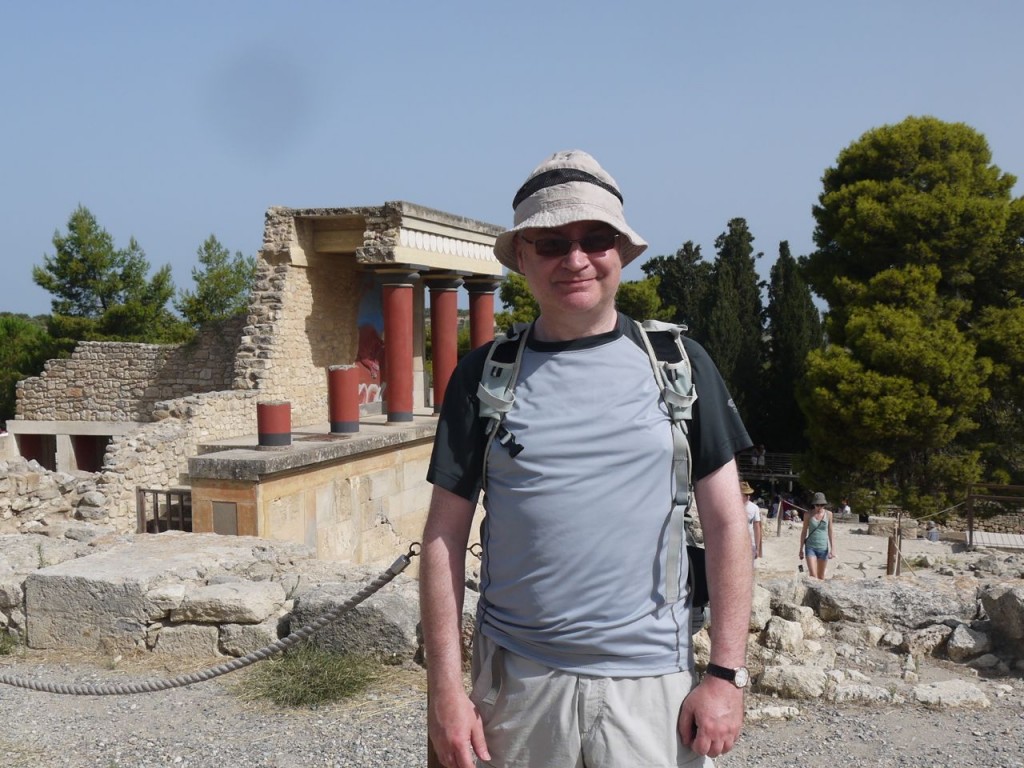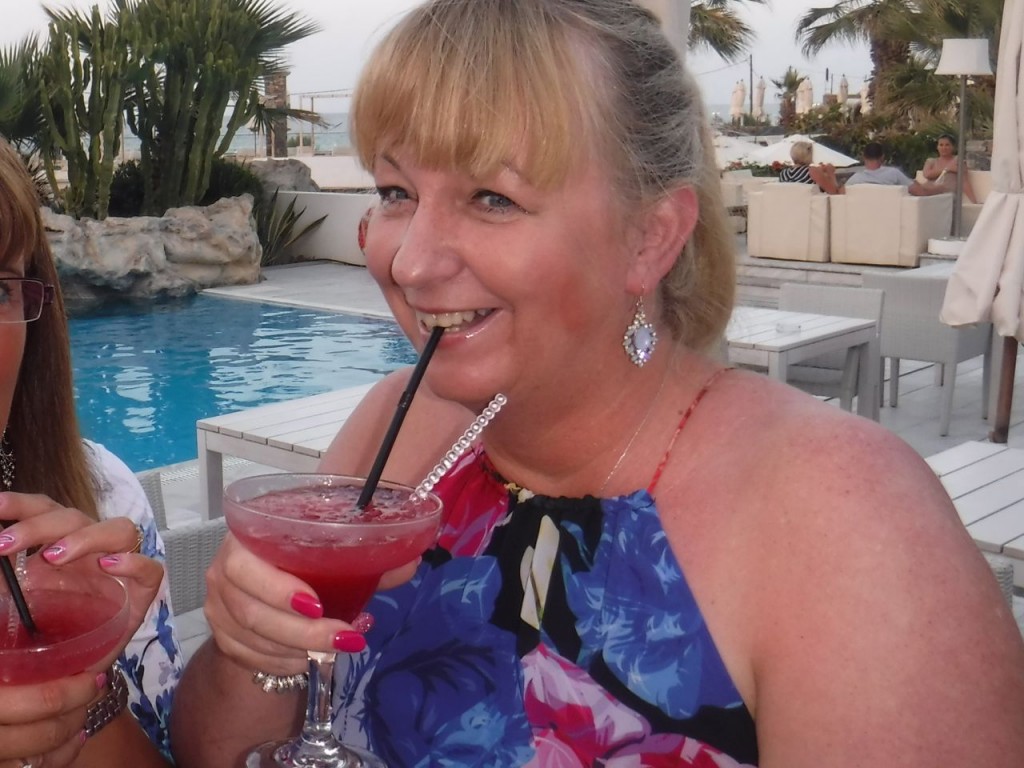Distance: Not much actual walking. Climb: Virtually none. Duration: Left after breakfast, back for lunch.
Knossos by bus
A journey rather than a walk, and certainly not an epic journey.
As I walked from the hotel I left the unreal order of its grounds with their manicured greenery, the sound of trickling water and the cool of its air conditioning and stepped into the real Crete. The morning sky was the colour of a Manchester City shirt. The sun-baked ground an earthy red where cultivated, and path a light grey. The uneven narrow road climbed slowly to my right winding cunningly to avoid casting any shade on my route so I soon had a layer of sweat but it was wasted since there was no breeze to draw off the latent heat of evaporation.
These first minutes were in a landscape of dust, straggly plants with small white snails littering their leaves and buildings built for fierce heat. I would not have been surprised to see a small boy leading a donkey around a well, or to meet a poncho’d rider as the plaintive music of Sergio Leone grew from silence through audible to palpable. I stopped to look ahead to a rocky prominence whose dark rock must have glowed red when it was born. How much larger would it have been when the loose rocks forming its skirt were still part of its peak?
Then the silence ended, and it was not music to the metre of a galloping horse but a wave of grasshopper trills. Actually they would be cicadas I suppose. They must wait until 9 o’clock to start their day’s work, but fair’s fair they do keep going until late in the night.
This narrow road led me to the main highway or more accurately a small road separated from the main road by a traffic barrier. I was on what amounted to an elongated lay- by, perhaps half a mile in length. A sign immediately ahead of me pointed left, “Taxi/Bus Stop 100m” which somewhat underestimated the distance. There was no bus stop at 100m, nor at 200m. Then I stopped counting paces.
My pre-outing intelligence gathering suggested the bus stop was where “the barrier ended and the roads joined together”. I plodded on in the burning sun and in the distance a bus emerged from the glimmering ground like a mirage. My brain made its calculations in a fraction of a second, “too far to make it even if I were to run” and threw in a few supportive aspects, “too hot to be running”, “if I run I’ll still miss the bus and
then have longer to wait at the bus stop”. A curiously twisted concept of time that last one, but the thought occurred.
Well, only half an hour until the next bus (more pre-outing intelligence gathering). If only I hadn’t paused by that tree and closed my eyes to find if the cicada’s noise was palpable I would have caught the bus. But the bus stayed where it was. Some complex movement of people about it continued. Luggage was being loaded into its side. A hindbrain reflex over ruled the previous calculations and I broke into a run. Hominid chases prey? Hominid runs from predator? No conscious thought this time, just action. Those millennia evolving on the East African savanna have left their mark.
This part of the tale can, alas, have only one ending.
I drew closer. The bus took on more specific features. The luggage flap was being closed. The passengers filed onto the bus. The bus did not move. Now I could see the driver. Elation. The bus moved. Despair. The bus stopped again. Elation. It pulled onto the road. Despair. Just on the road immediately alongside me it stopped again. Elation. The driver looked at me, then drove away. “No….oo…ooo”. If this was a film, the camera would pan out to accentuate my isolation, showing the growing distance between me and the bus I was fated to miss. I can only presume that earlier in the day, some event had predicated the driver’s actions. Perhaps rather than starting the day with a hearty breakfast prepared by a lovely smiling wife, he had arrived at work hungry, poured sour milk into his coffee and then banged his head getting in the bus.
As I looked for some shade in which to pass the next thirty minutes I could have mused about free will versus determinism but instead looked at my watch so I could count the minutes away in the shade of a nearby tree. There was not as far as I could see any sign to mark this spot as a bus stop, so in a way, seeing a bus actually stopping here was a gift of sorts. I watched the passing cars and wondered if the number plates used Greek or Roman lettering. I only saw Roman lettering but perhaps the cars I saw had by chance characters present in both alphabets. By the end of the day I was convinced that the number plates used Roman lettering. Perhaps there is some EU directive that requires it. That had me wondering what system of numbers the Ancient Greek’s used. I seem to remember that they did not have a number system but wrote the names of numbers out fully, I must look that up.
Now that sounds like a long time thinking, but it was a very short time indeed since the next bus, of the “every half hour” schedule, came just three minutes after the previous one had left. The bus pulled up, despite the absence of a bus stop sign, and the driver gazed at me through the closed door. Was this some form of test? Perhaps there was a sign that would show I wished to board. I mimed getting on the bus. The driver was unmoved. A voice somewhere was saying something but I couldn’t make it out. I repeated my mime, which incidentally came without any great amount of conscious thought. In miming I turned enough to notice someone leaning out of the door half way down the bus. I didn’t understand the words but the beckoning arm was clear enough. I can imagine him, who was in fact the conductor, and the driver having a good laugh later about the numpty dancing outside the front door of the bus. Mad dogs and Englishmen may go out in the midday sun but only Mancunian born Doonhamers dance beside buses in that sun.
Though a bus in concept and action, this was actually a coach, so there were a few steps to climb and as we pulled onto the road the conductor beckoned again and took me to the only remaining seat, occupied by a bag (a hold-all that is, not a female crone). A brief tirade in Greek and the other passenger moved the bag to his knee, I sat down and was asked for 2 euros 20. My attire, in the style of modern Englishman abroad (think Benidorm rather than Graham Green), or perhaps my reply “yes” to the question “Iraklion?”, had I presume made English the language most likely to convey concepts clearly.
So I settled down in the comfort of an air conditioned Minoan bus line coach to enjoy the ride to Heraklion. I didn’t have a window seat so my view was along the aisle and through the windscreen. The landscape would have passed muster for any alien planet film. Where we drove by rocky outcrops their volcanic origin was obvious. I wondered if the volcanic islands just off the coast had been formed at a time when people might have watched their genesis, like the new islands off Iceland. But if so surely such events would have survived in the myths and legends passed down to us? So perhaps not.
We drove past other bus stops with people waiting, presumably because the bus was full. I was glad that I hadn’t waited thirty minutes for a bus that then just drove by. I would have been left wondering if I was not waiting at a bus stop or if I had failed to make the necessary signal. But today Lady Luck had chosen to bestow a smile upon me.
The bus called at the airport giving me another look at the gate guardian, an F-5 I think. It does make me feel a little old to see aircraft I have seen in active service mounted on plinths.
Soon enough the bus was in the narrow streets of Heraklion. The driver, until now a silent rock controlling our journey, revealed his animated voluble persona. I would have described his outbursts as “Latin”, which shows how easily one can fall into using stereotypes. I’m pretty sure his behaviour can be found in harassed bus drivers the world over, and perhaps it is the style rather than the behaviour I recognise and categorise as Latin. Hellenic doesn’t carry the same associations, being more suggestive of philosophical discourse, mathematics and geometry. It’s strange how stereotypes evolve.
The streets of Heraklion, at least those the bus used, would have been more than adequate for a Venetian merchant half a millennium ago, or even his Cretan successor half a century ago. But lined as they now are with parked cars, including some parked by sociopaths exhibiting no concern whatsoever for other road users, they are barely adequate for inclusion in a bus route. One outburst was from a passenger about to disembark when a car sped past on the near side. (Is that undertaking? (No that’s burials, it must be overtaking on the near side). Anyway I presume the passenger was proclaiming his near death experience but the driver was reacting as if personally insulted by the passenger. A terse exchange.
I don’t intend to denigrate Heraklion, and to be fair I didn’t explore the town but it is like many a Mediterranean town, a core of ancient buildings left by yesteryear’s overlords, in this case Venetians, and modern hot climate buildings interspersed with more modern glass constructions which are found the world over. Open shop fronts and outdoor cafes proclaim that this is the Med, while cafe tables with ash trays seem unusual for one from Scotland.
There are small statues dotted about the town and it was a shame to not understand what they represented. One which appeared to show gymnasts might I suppose be harking back to Theseus and the Minotaur.
The bus drew in to Heraklion bus station and I stepped back into the heat. Next task, find the Knossos bus. I joined the queue at the ticket office and though I found myself slightly disadvantaged by my personal concept of queuing (warning to self, watch those stereotypes), I was soon at the window. But no ticket for me, “Not here, out there, turn right”. Outside to the right was a strange raised booth, somewhat reminiscent of a Punch and Judy set up. The window and its opening just too high to comfortably reach. Inside was a man with the look of one guiding his ship through a Baltic storm, the ship’s rigging torn loose in a raging wind, just after the first mate has told him “the rudder’s gone, cap’n. The men know they’re done for and have broken into the brandy barrels.” His job spec must have had “must appear unapproachable” in the essential requirements category.
I stood gathering scraps of left over courage together when he left his booth and walked over to a group of bus drivers suddenly all bon homie. Not so bad after all. When he came back I asked where the bus for Knossos was and he pointed across the station.
Another ticket office and this one with a sign, “Knossos every 10-20 minutes”. €3.60 return and the information I needed, “number 2, behind these buses”. Six buses stood behind those buses, none bore the number 2, but then a driver climbed into one and it’s sign changed to “2 Knossos”. I handed in my ticket and went to find a seat, was called back to collect the ticket stub, then took a seat.
This was on of those bus routes where there is a stop every few hundred metres so I got to see a little more of urban Heraklion before the town gave way to olive trees and other greenery. A recorded voice announced the next stop and it appeared on an electronic sign. I quickly realised though that the next place the bus stopped was not called επόμενη στάση as this was announced before every stop. Why have a sign that just reads “next stop” but does not say what stop it actually is? I was however able to marvel at the likeness between stop in Greek, στάση (stashi) and stage in English.
People got on and off. The bus filled with both tourists and locals. At one stop the announcement sounded like “epomeni stashi ariadne”. Well I was going to Knossos, not Ariadne so I stayed put. Most people were going to this Ariadne place though. I thought perhaps it might be a museum.
Now, I have had this experience before so it didn’t take too long for the penny to drop. Everybody got off leaving just me and the driver. He said something I didn’t understand, which again sounded like Ariadne, but when he indicated the area and said “Knossos” I got the drift and got off.
Lots of people, all in tourist garb, numerous tat shops, I should have known. Not sure where to head I just ambled along the road and then noticed a small sign “palace 50m” . The queue for tickets was relatively small and didn’t extend beyond the shaded area so I was still relatively cool when I paid my €6 and entered the Palace of Knossos.
I decided not to join an organised tour, or hire a personal tour guide. I had read a little about the ruins before coming and there were plenty of information boards dotted about. It was easy to get away from the crowded routes and rather than stare at specific buildings I wandered about imagining what the views might have been from various places around the palace. On the slopes opposite the palace most of the land looked wild but some terraced areas were cultivated. One field drew my attention since it was sparkling in the sunshine much like snow does. I can’t think what that could be other than rock crystals in the soil.
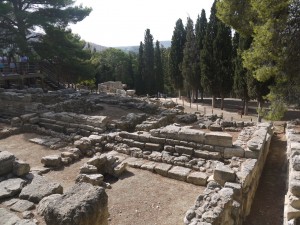 Some of the ruins have been reconstructed and painted, as was the way of archeologists in Victorian times. It does I suppose cock up the ruins for future archeologists but gives the casual visitor some idea of what it may have looked like. Obviously the Minotaur appears on a mural.
Some of the ruins have been reconstructed and painted, as was the way of archeologists in Victorian times. It does I suppose cock up the ruins for future archeologists but gives the casual visitor some idea of what it may have looked like. Obviously the Minotaur appears on a mural.
This was once a substantial building, and built to impress visitors judging by the layout. Standing amongst some mature trees in what must once have been a courtyard, and seeing plants reclaiming the ruins themselves brought Ozymandias to mind, though that is perhaps a little unfair since there is no sign that the Minoans made the same claims as he. A few flowering plants grew near the entrance adding colour and I imagine the palace itself in its heyday must have been more alive with plants than the desert of ruins we are now presented with.
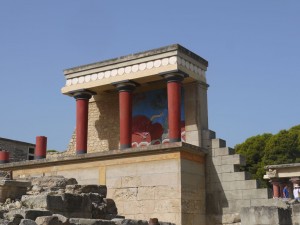 I think I enjoyed standing alone beneath those trees imagining the palace as it once was. It is sad though to see a ruin frozen in time. Perhaps if tourism did not need it, it would be more natural to allow it to age (or perhaps decay would be more accurate) naturally. A weed covered ruin would appeal to me more than this attempt to present a “clean” ruin, but visitors scampering over it would soon destroy it. On reflection, it’s life as a palace is long past, it’s archeological secrets have been read and it is better it continue in use sustaining tourism than just decaying unused. I wonder if we uncovered the site of the Hanging Gardens of Babylon we would display the walls without the plants?
I think I enjoyed standing alone beneath those trees imagining the palace as it once was. It is sad though to see a ruin frozen in time. Perhaps if tourism did not need it, it would be more natural to allow it to age (or perhaps decay would be more accurate) naturally. A weed covered ruin would appeal to me more than this attempt to present a “clean” ruin, but visitors scampering over it would soon destroy it. On reflection, it’s life as a palace is long past, it’s archeological secrets have been read and it is better it continue in use sustaining tourism than just decaying unused. I wonder if we uncovered the site of the Hanging Gardens of Babylon we would display the walls without the plants?
Well, the ruins of the Palace of Knossos allowed me to commune with the past and the present if only for a few minutes. Very few people strayed away from the path, and even though I stood in a public area, one of the few that was shaded, only a couple of other people came that way, one pushing the other in a stroller.
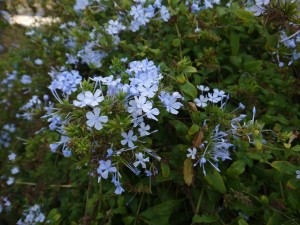 The journey back was at least on bus routes I already knew, albeit in reverse. I found a bus stop and a bus turned up within five minutes. It wasn’t the number 2 but the driver announced
The journey back was at least on bus routes I already knew, albeit in reverse. I found a bus stop and a bus turned up within five minutes. It wasn’t the number 2 but the driver announced
“Heraklion”, so on I got and it retraced the same route back to the bus station. Here I went back to the original ticket office and bought my ticket to Gouves. The ticket man looked marginally irritated when I asked what number bus I needed, but told me it was the number 8. Walking away I looked at my ticket which had in large bold lettering, “number 8”. RTFM, eh? The timetable told me that my bus was leaving in 15 minutes. It was the Malia route and I passed a little time trying to photograph the bus with “Malia” on the front but the camera couldn’t cope with the electronic sign, producing images looking like a histogram, even when I tried using the camera’s burst mode. The human eye and camera sensor work differently.
The angry man from the Punch and Judy stall earlier in the day, head of the station by the look of things, was laughing again with the drivers so I had probably
had misjudged him on the first pass.
My only concern now was knowing when to get off the bus. I decided I should sit on the near side so I could watch for the long layby. This meant sitting in the sun rather than the shade, but I didn’t want to miss my stop. The conductor looked at my ticket when we passed the airport and asked where I was getting off so he could tell the driver to stop there. I recalled that Lynn had showed me a comment on Tripadvisor about asking for stop 13, so stop 13 it was. I could have sat in in the shade after all.
The journey back was by a different route initially, much smaller roads, more stops, but eventually we rejoined the main road and I was deposited at stop 13. This was not where I had joined the bus but the other end of the long layby. I crossed the road, which was more of a challenge than it sounds, drank the rest of my water, then struck out for the walk back to the hotel, passing fields of Aloe Vera and stands of bamboo, not things one sees in sunny Scotland, though I do think there was bamboo in Kirroughtree forest.
The final few hundred metres were downhill, with the thought of a cool drink only minutes away. The usual stream of Boeing 737/Airbuses overhead was even interrupted by a Hercules, adding a little variety, and a linguistic connection to the area, I suppose.
A micro adventure complete. I hadn’t fancied the organised excursion to Knossos, since it included the inevitable, “and then you have the opportunity to enjoy/explore/have a beer/eat lunch” for two hours. I have been there/tasted the wares/got the tee shirt when it comes to visiting “family” olive oil pressing/firewater distilling/honey making establishments and overall found this outing much more enjoyable.

